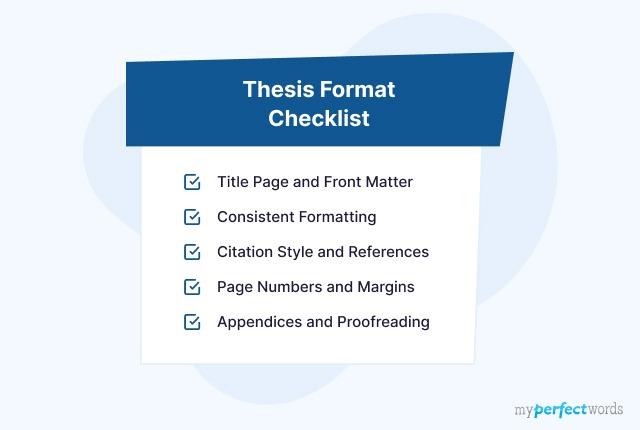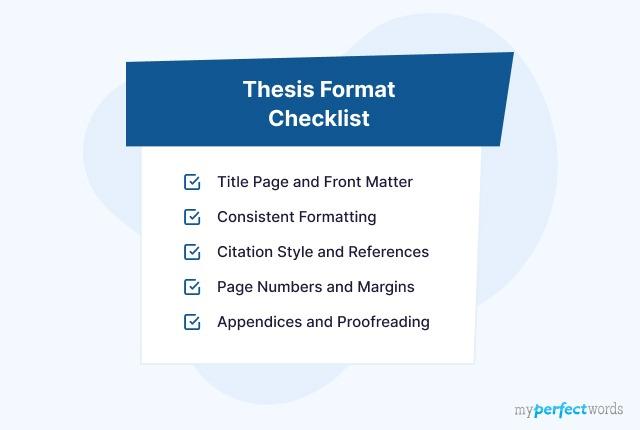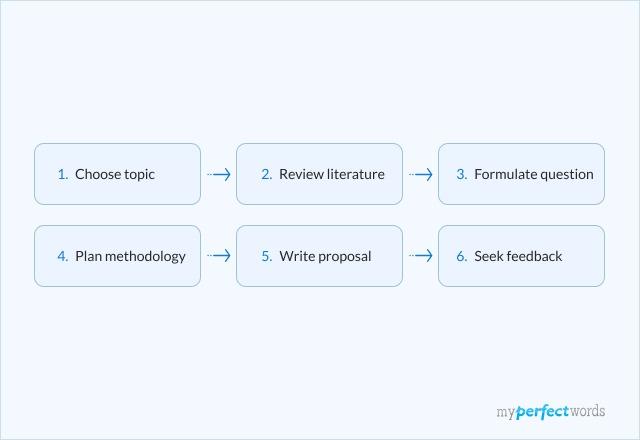

Are you feeling overwhelmed by the thought of formatting your thesis or dissertation? It's a common challenge that many graduate students and researchers face.
The requirements and guidelines for thesis writing can be complex and demanding, leaving you in a state of confusion.
You may find yourself struggling with questions like:
How do I structure my thesis properly?
What are the formatting rules I need to follow?
Don't worry!
In this comprehensive blog, we will explain the thesis format step by step.
Whether you're a graduate student or a postdoctoral researcher, our thesis format guide will assist you in academic writing.
Let's get started!
On This Page![]()
- 1. What is a Thesis and a Dissertation?
- 2. How to Structure a Thesis - The Formatting Basics
- 3. Thesis Format Guidelines
- 4. Thesis Format Sample
- 5. Thesis Paper Formatting Tips
What is a Thesis and a Dissertation?
At some point in your academic journey, you've likely come across the terms "thesis" and "dissertation," but what exactly are they, and how do they differ?
A thesis and a dissertation both represent substantial pieces of academic work, sharing some similarities, but they also have distinct characteristics.
A thesis is typically associated with undergraduate or master's degree programs. It represents a student's independent research and findings on a specific topic. The objective is to demonstrate a deep understanding of the subject matter and the ability to conduct research.
On the other hand,
A dissertation is commonly linked with doctoral programs. It's a more extensive and comprehensive research project that delves into a specific area of study in great detail. Doctoral candidates are expected to make an original contribution to their field of knowledge through their dissertation.
Give a read to our thesis vs dissertation blog to learn the difference!
How to Structure a Thesis - The Formatting Basics
Structuring your thesis is a crucial aspect of academic writing. The thesis format font size and spacing follows a specific framework.
A well-organized thesis not only enhances readability but also reflects your dedication to the research process.
The structure can be divided into three main sections: Front Matter, Body, and End Matter.
Front Matter
- Title Page: The title page is the very first of preliminary pages of your thesis. It typically includes the thesis title, your name, the name of your institution, and the date of submission.
- Abstract: The abstract is a concise summary of your thesis, providing readers with a brief overview of your research problem, methodology, key findings, and conclusions.
- Table of Contents: A well-organized table of contents lists all the main sections, subsections, and corresponding page numbers within your thesis.
- List of Figures and Tables: If your thesis contains figures and tables, create a separate list with captions and page numbers for easy reference.
- List of Abbreviations or Acronyms: If you've used abbreviations or acronyms in your thesis, include a list to explain their meanings.
- List of Symbols: If your research involves symbols or special characters, provide a list of these elements and their definitions.
- Acknowledgments: In this section, you can acknowledge individuals or institutions that have supported your research and thesis writing process.
- Dedication (Optional): Some students choose to include a dedication page to honor someone or express personal sentiments.
- Preface (Optional): In the preface, you can explain the background and context of your research, providing additional context for the reader.
Body
- Introduction: The introduction sets the stage for your thesis. It introduces the research problem, its significance, research objectives, and research questions.
- Literature Review: The literature review section provides a comprehensive review of existing literature and research related to your topic. It helps establish the context for your research.
- Methodology: Describe the research methods and techniques you employed in your study. Explain how you collected and analyzed data.
- Results: Present your research findings in a clear and organized manner. Use tables, figures, and charts to illustrate key points.
- Discussion: Interpret the results and discuss their implications. Address any limitations and suggest areas for future research.
- Conclusion: Summarize the main findings and their importance. Restate the research questions and provide a final perspective on the topic.
End Matter
- References: List all the sources you cited in your thesis, following a specific citation style (e.g., APA, MLA, Chicago).
- Appendices: Include any supplementary materials, such as raw data, surveys, questionnaires, or additional information that supports your research.
- Vita (Optional): Some academic institutions require or allow a vita, which is essentially a brief academic resume or biography.
By following this structured framework for your thesis, you'll ensure that your research is presented in a clear and organized manner, meeting the formatting basics and academic standards.
Thesis Format Guidelines
Formatting your thesis makes your research work not just look good but also helps others understand it easily.
These guidelines show you how to structure and organize your thesis neatly, from the title page to the reference section.
- Page Layout:
- Use standard 8.5 x 11-inch paper.
- Set 1-inch margins on all sides.
- Font:
- Use a readable and professional font such as Times New Roman, Arial, or Calibri.
- Font size for the main text should typically be 12 points.
- Line Spacing:
- Use double-spacing throughout the document.
- Exceptions include footnotes, long quotations, and the bibliography, which may be single-spaced.
- Heading Structure:
- Use a clear and hierarchical heading structure to organize your content.
- Differentiate between main headings and subheadings with bold, italics, or size variations.
- Page Numbering:
- Page numbers are typically placed in the header or footer.
- Number the pages consecutively throughout the document.
- Arabic numerals or roman numerals are used for the body of the thesis.
- Title Page:
- The title page should include the thesis title, your name, institutional affiliation, and the date of thesis submission.
- Follow your institution's specific guidelines for title page formatting.
- Table of Contents:
- Create a well-organized table of contents listing all sections and subsections with corresponding page numbers.
- Use a clear and consistent format for this section.
- List of Figures and Tables:
- If applicable, provide separate lists for figures and tables, including captions and page numbers.
- Ensure consistent formatting for these lists.
- Abstract:
- Present a concise summary of the thesis, highlighting the research problem, methodology, key findings, and conclusions.
- Typically, the abstract is on a separate page immediately following the title page.
- Citations and References:
- Follow a specific citation style consistently throughout your thesis (e.g., APA, MLA, Chicago).
- Ensure that in-text citations and references are accurate and properly formatted.
- Page Breaks:
- Use page breaks to separate sections properly. This ensures that your chapters and other major divisions begin on new pages.
- Margins:
- Maintain the required margins (usually 1 inch) on all sides, including the top, bottom, left, and right.
- Appendices:
- If you include appendices, ensure they follow the same formatting rules as the main body of the thesis.
You can also refer to the below-given document to understand the format template of a thesis paper.
Thesis Format Sample
Here are some thesis format examples to get a better understanding.
Thesis Paper Formatting Tips
Formatting your thesis paper correctly is not only about making it look neat and professional but also about meeting the stringent requirements set by your academic institution.
Whether you're in the early stages of writing your thesis or preparing for submission, these tips will help you in formatting.
- Adhere to Institutional Guidelines: Follow your institution's specific formatting requirements, including thesis format margins, font styles, and citation styles.
- Consistency in Formatting: Maintain uniform font, font size, and spacing throughout the thesis for a professional appearance.
- Proper Page Numbering: Place page numbers correctly in the header or footer, starting with the first chapter after the front matter.
- Title Page Accuracy: Ensure the title page contains the accurate title, your name, institutional affiliation, and submission date.
- Organized Table of Contents: Create a well-structured table of contents listing all sections and subsections with page numbers.
- List of Figures and Tables: Provide separate, well-labeled lists for figures and tables, including captions and page numbers.
In conclusion,
This blog has provided valuable insights into the essential aspects of formatting a thesis paper.
By following these tips, students can ensure that their research is not only well-structured and polished but also meets the rigorous standards set by their academic institutions.
Formatting and writing a thesis is a challenging task for most people, as it requires a lot of time.
Instead of risking your grades, hire an expert writer who is dedicated and experienced in his work.
You can buy thesis from us, and our qualified writing experts will guarantee top-quality results delivered within the deadlines!
We are proficient in coping with various academic tasks. Just tell us to 'do my essay' and we'll get the job done precisely and with exceptional quality!

Write Essay Within 60 Seconds!
Use our AI tool to generate high quality essay
WRITTEN BY
Caleb S.
Caleb S. has been providing writing services for over five years and has a Masters degree from Oxford University. He is an expert in his craft and takes great pride in helping students achieve their academic goals. Caleb is a dedicated professional who always puts his clients first.




